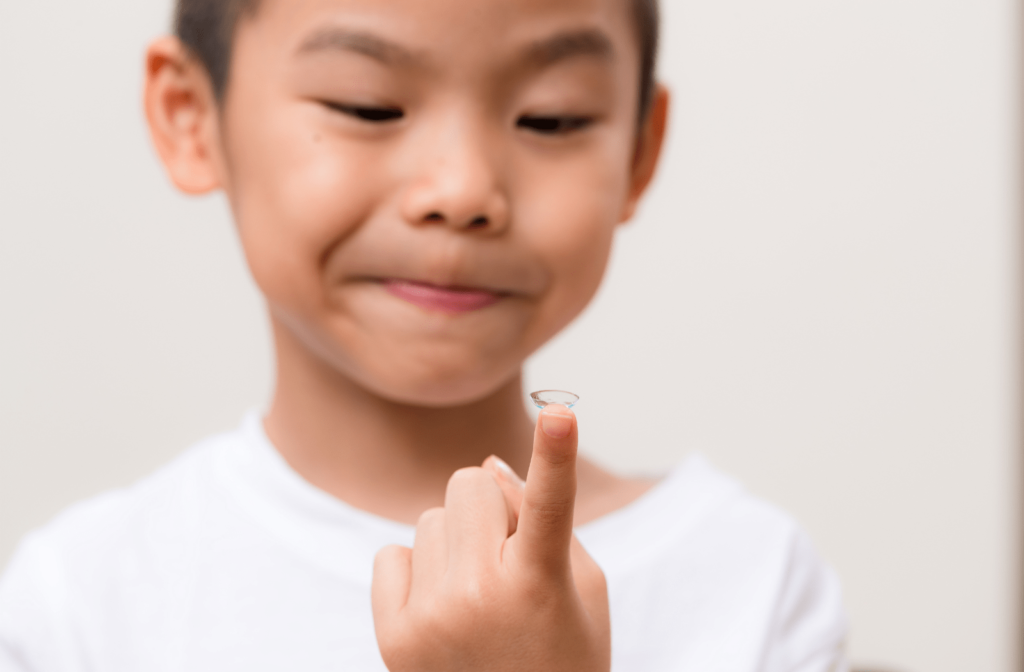Children’s eye exams are vital for vision care and help to identify vision problems early to correct them before they worsen. As a parent, when you think of vision correction in kids, the first option that comes to mind may be glasses.
But glasses aren’t the only option. Contact lenses can also provide vision correction as a temporary break from glasses or a permanent change. The contact lens process starts with a contact lens exam and fitting.
If your child is considering contact lenses, you may wonder if they are the right age. So what is the right age to start wearing contact lenses? Let’s learn more about contact lenses for kids, the benefits, and if there’s a right age to start wearing them.
Kids & Contact Lenses
There is no recommended age to start wearing contact lenses. It may be surprising to learn that even infants wear contact lenses after cataract surgery.
According to the Canadian Association of Optometrists, children younger than 12 reported better vision-related quality of life with contact lenses than with glasses. And children as young as 8 can have success wearing contact lenses.
Wearing contact lenses as a beginner or switching from glasses has less to do with age and more with responsibility and care. The decision to start your child on contacts is usually jointly decided by the parent, child, and their eye doctor.
Factors that influence that decision can include the following:
Responsibility & Hygiene
Contact lenses are safe but require more care and cleaning compared to glasses. Children 8 and over are usually more responsible, have better hygiene habits, and don’t need reminding when to brush their teeth or do their chores.
Reasons for Contacts
There are many reasons why a child might want contact lenses. These can include:
- Eyeglasses discomfort: From improper fit or prescription.
- Participation in sports: More breakage and damage to eyeglasses with contact sports.
- Low self-esteem: Self-consciousness about how they look with eyeglasses.
- Prescription: Specially designed contacts can slow the progression of myopia or nearsightedness.
What Contacts are Best for Kids?
A contact lens exam and fitting with questions on lifestyle and medical needs determine the type of contact lens for a child. These include extended wear or daily disposables, soft or hard lenses or a specific type of lens for vision problems.
Contact lenses generally recommended for kids are:
Daily Disposables
Daily disposables reduce the risk of infections because they get discarded every day before kids go to bed with no reuse or fuss with cleaning solutions.
Weekly and Monthly Disposables
Weekly disposables last for 1 to 2 weeks and monthly for extended wear. Both are more durable. However, they require disinfection with lens solution and storage every night. They may be more suitable for older kids.
Rigid Gas Permeable (RGP)
Compared to the above soft lenses, these are known as hard lenses. They are best suited for children with vision conditions but can make adjusting harder.
Benefits of Contacts
There are many benefits to wearing contact lenses. The main ones why children prefer contacts over glasses include:
- Soft lenses are more comfortable with easy adjusting.
- They provide a wide field of vision, stay in place when playing sports, and offer a better and clearer visual experience with the correct prescription.
- You can wear sunglasses with your contacts.
Things to Consider for Kids with Contacts
If an eye doctor recommends contacts, there are some things parents should keep in mind when their kids start wearing them even after receiving instructions:
- Contact Lens Wear: Kids should remove their contacts before bed, even if they have extended wear contacts, to prevent oxygen deprivation to the cornea. There is also an increased risk of infection with overwear of contact lenses.
- Training: Receive training with the correct technique for inserting and removing contacts. Parents are there for support and help, but the child has to be confident and not have anxiety about putting contact lenses in their eyes.
- Cost: You may not be replacing contacts as much as glasses in the case of contact sports or rapidly changing prescriptions. However, your child should have a backup pair of glasses or contacts for emergencies.
Make the Switch to Contacts
The best way to determine when your child can start wearing contacts is if they are ready to care for them as needed. Contact lenses are not permanent, and if a child finds the added responsibility too much, they can always switch back to glasses and try again later.
Contact lenses may not be suitable for all children. Call Eye Effects today to find the right solution for your child.


